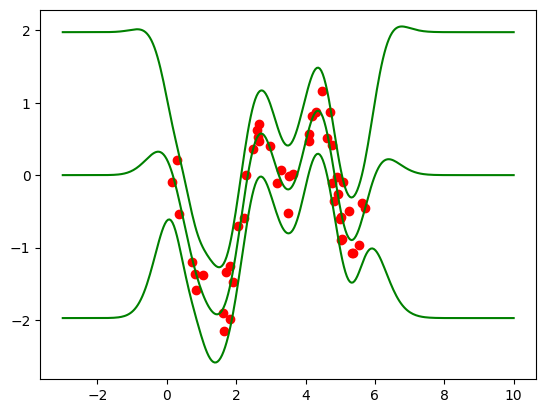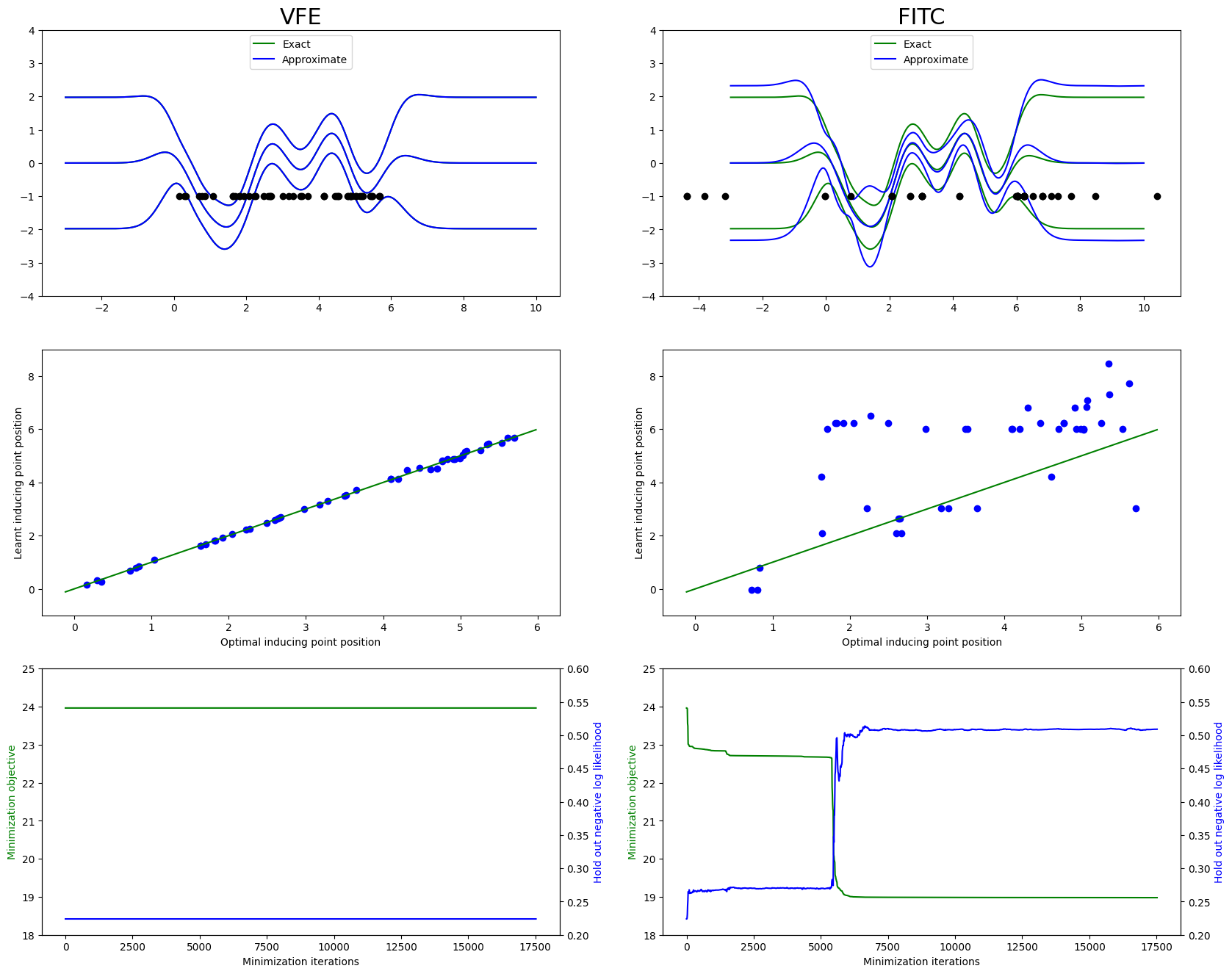Comparing FITC approximation to VFE approximation#
This notebook examines why we prefer the Variational Free Energy (VFE) objective to the Fully Independent Training Conditional (FITC) approximation for our sparse approximations.
[1]:
import matplotlib.pyplot as plt
from FITCvsVFE import (
getTrainingTestData,
plotComparisonFigure,
plotPredictions,
printModelParameters,
repeatMinimization,
stretch,
)
import gpflow
from gpflow.ci_utils import reduce_in_tests
%matplotlib inline
# logging.disable(logging.WARN) # do not clutter up the notebook with optimization warnings
2022-12-02 11:14:53.628715: I tensorflow/core/platform/cpu_feature_guard.cc:193] This TensorFlow binary is optimized with oneAPI Deep Neural Network Library (oneDNN) to use the following CPU instructions in performance-critical operations: AVX2 AVX512F FMA
To enable them in other operations, rebuild TensorFlow with the appropriate compiler flags.
2022-12-02 11:14:53.745770: W tensorflow/stream_executor/platform/default/dso_loader.cc:64] Could not load dynamic library 'libcudart.so.11.0'; dlerror: libcudart.so.11.0: cannot open shared object file: No such file or directory
2022-12-02 11:14:53.745790: I tensorflow/stream_executor/cuda/cudart_stub.cc:29] Ignore above cudart dlerror if you do not have a GPU set up on your machine.
2022-12-02 11:14:53.774640: E tensorflow/stream_executor/cuda/cuda_blas.cc:2981] Unable to register cuBLAS factory: Attempting to register factory for plugin cuBLAS when one has already been registered
2022-12-02 11:14:54.397078: W tensorflow/stream_executor/platform/default/dso_loader.cc:64] Could not load dynamic library 'libnvinfer.so.7'; dlerror: libnvinfer.so.7: cannot open shared object file: No such file or directory
2022-12-02 11:14:54.397144: W tensorflow/stream_executor/platform/default/dso_loader.cc:64] Could not load dynamic library 'libnvinfer_plugin.so.7'; dlerror: libnvinfer_plugin.so.7: cannot open shared object file: No such file or directory
2022-12-02 11:14:54.397154: W tensorflow/compiler/tf2tensorrt/utils/py_utils.cc:38] TF-TRT Warning: Cannot dlopen some TensorRT libraries. If you would like to use Nvidia GPU with TensorRT, please make sure the missing libraries mentioned above are installed properly.
/home/circleci/project/gpflow/experimental/utils.py:42: UserWarning: You're calling gpflow.experimental.check_shapes.decorator.check_shapes which is considered *experimental*. Expect: breaking changes, poor documentation, and bugs.
warn(
/home/circleci/project/gpflow/experimental/utils.py:42: UserWarning: You're calling gpflow.experimental.check_shapes.inheritance.inherit_check_shapes which is considered *experimental*. Expect: breaking changes, poor documentation, and bugs.
warn(
First, we load the training data and plot it together with the exact GP solution (using the GPR model):
[2]:
# Load the training data:
Xtrain, Ytrain, Xtest, Ytest = getTrainingTestData()
def getKernel():
return gpflow.kernels.SquaredExponential()
# Run exact inference on training data:
exact_model = gpflow.models.GPR((Xtrain, Ytrain), kernel=getKernel())
opt = gpflow.optimizers.Scipy()
opt.minimize(
exact_model.training_loss,
exact_model.trainable_variables,
method="L-BFGS-B",
options=dict(maxiter=reduce_in_tests(20000)),
tol=1e-11,
)
print("Exact model parameters:")
printModelParameters(exact_model)
figA, ax = plt.subplots(1, 1)
ax.plot(Xtrain, Ytrain, "ro")
plotPredictions(ax, exact_model, color="g")
/home/circleci/project/gpflow/experimental/utils.py:42: UserWarning: You're calling gpflow.experimental.check_shapes.checker.ShapeChecker.__init__ which is considered *experimental*. Expect: breaking changes, poor documentation, and bugs.
warn(
2022-12-02 11:14:56.957075: W tensorflow/stream_executor/platform/default/dso_loader.cc:64] Could not load dynamic library 'libcuda.so.1'; dlerror: libcuda.so.1: cannot open shared object file: No such file or directory
2022-12-02 11:14:56.957100: W tensorflow/stream_executor/cuda/cuda_driver.cc:263] failed call to cuInit: UNKNOWN ERROR (303)
2022-12-02 11:14:56.957117: I tensorflow/stream_executor/cuda/cuda_diagnostics.cc:156] kernel driver does not appear to be running on this host (7394a4ccd063): /proc/driver/nvidia/version does not exist
2022-12-02 11:14:56.957357: I tensorflow/core/platform/cpu_feature_guard.cc:193] This TensorFlow binary is optimized with oneAPI Deep Neural Network Library (oneDNN) to use the following CPU instructions in performance-critical operations: AVX2 AVX512F FMA
To enable them in other operations, rebuild TensorFlow with the appropriate compiler flags.
Exact model parameters:
Likelihood variance = 0.074285
Kernel variance = 0.90049
Kernel lengthscale = 0.5825

[3]:
def initializeHyperparametersFromExactSolution(sparse_model):
sparse_model.likelihood.variance.assign(exact_model.likelihood.variance)
sparse_model.kernel.variance.assign(exact_model.kernel.variance)
sparse_model.kernel.lengthscales.assign(exact_model.kernel.lengthscales)
We now construct two sparse model using the VFE (SGPR model) and FITC (GPRFITC model) optimization objectives, with the inducing points being initialized on top of the training inputs, and the model hyperparameters (kernel variance and lengthscales, and likelihood variance) being initialized to the values obtained in the optimization of the exact GPR model:
[4]:
# Train VFE model initialized from the perfect solution.
VFEmodel = gpflow.models.SGPR(
(Xtrain, Ytrain), kernel=getKernel(), inducing_variable=Xtrain.copy()
)
initializeHyperparametersFromExactSolution(VFEmodel)
VFEcb = repeatMinimization(
VFEmodel, Xtest, Ytest
) # optimize with several restarts
print("Sparse model parameters after VFE optimization:")
printModelParameters(VFEmodel)
WARNING:tensorflow:5 out of the last 34 calls to <function Scipy.eval_func.<locals>._tf_eval at 0x7f1cfb225ea0> triggered tf.function retracing. Tracing is expensive and the excessive number of tracings could be due to (1) creating @tf.function repeatedly in a loop, (2) passing tensors with different shapes, (3) passing Python objects instead of tensors. For (1), please define your @tf.function outside of the loop. For (2), @tf.function has reduce_retracing=True option that can avoid unnecessary retracing. For (3), please refer to https://www.tensorflow.org/guide/function#controlling_retracing and https://www.tensorflow.org/api_docs/python/tf/function for more details.
WARNING:tensorflow:5 out of the last 13 calls to <function Scipy.eval_func.<locals>._tf_eval at 0x7f1cfc6b95a0> triggered tf.function retracing. Tracing is expensive and the excessive number of tracings could be due to (1) creating @tf.function repeatedly in a loop, (2) passing tensors with different shapes, (3) passing Python objects instead of tensors. For (1), please define your @tf.function outside of the loop. For (2), @tf.function has reduce_retracing=True option that can avoid unnecessary retracing. For (3), please refer to https://www.tensorflow.org/guide/function#controlling_retracing and https://www.tensorflow.org/api_docs/python/tf/function for more details.
Sparse model parameters after VFE optimization:
Likelihood variance = 0.074286
Kernel variance = 0.90049
Kernel lengthscale = 0.5825
[5]:
# Train FITC model initialized from the perfect solution.
FITCmodel = gpflow.models.GPRFITC(
(Xtrain, Ytrain), kernel=getKernel(), inducing_variable=Xtrain.copy()
)
initializeHyperparametersFromExactSolution(FITCmodel)
FITCcb = repeatMinimization(
FITCmodel, Xtest, Ytest
) # optimize with several restarts
print("Sparse model parameters after FITC optimization:")
printModelParameters(FITCmodel)
Sparse model parameters after FITC optimization:
Likelihood variance = 0.018996
Kernel variance = 1.3297
Kernel lengthscale = 0.61727
Plotting a comparison of the two algorithms, we see that VFE stays at the optimum of exact GPR, whereas the FITC approximation eventually ends up with several inducing points on top of each other, and a worse fit:
[6]:
figB, axes = plt.subplots(3, 2, figsize=(20, 16))
# VFE optimization finishes after 10 iterations, so we stretch out the training and test
# log-likelihood traces to make them comparable against FITC:
VFEiters = FITCcb.n_iters
VFElog_likelihoods = stretch(len(VFEiters), VFEcb.log_likelihoods)
VFEhold_out_likelihood = stretch(len(VFEiters), VFEcb.hold_out_likelihood)
axes[0, 0].set_title("VFE", loc="center", fontdict={"fontsize": 22})
plotComparisonFigure(
Xtrain,
VFEmodel,
exact_model,
axes[0, 0],
axes[1, 0],
axes[2, 0],
VFEiters,
VFElog_likelihoods,
VFEhold_out_likelihood,
)
axes[0, 1].set_title("FITC", loc="center", fontdict={"fontsize": 22})
plotComparisonFigure(
Xtrain,
FITCmodel,
exact_model,
axes[0, 1],
axes[1, 1],
axes[2, 1],
FITCcb.n_iters,
FITCcb.log_likelihoods,
FITCcb.hold_out_likelihood,
)

A more detailed discussion of the comparison between these sparse approximations can be found in Understanding Probabilistic Sparse Gaussian Process Approximations by Bauer, van der Wilk, and Rasmussen (2017).